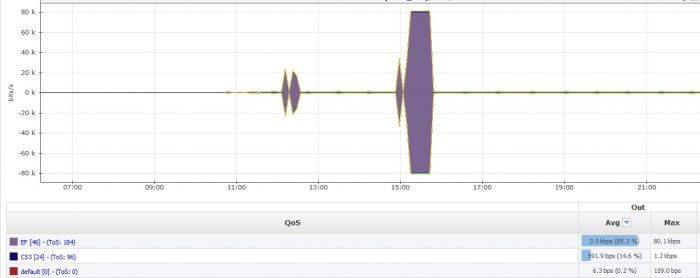In a day-to-day life of Network and security admins, QoS (Quality of Service) is a crucial mechanism in ordering all the data that travels through the network. QoS provides traffic prioritization as it enables a different level of importance to different applications to produce the highest level of performance possible.
QoS is based on ToS (Type of Service) or DSCP (Differentiated Services Code Point), and it can be represented as a slow/fast lane in traffic. Meaning, if you have an online conference and your video needs to have a good performance, QoS will make sure that it has a higher level of importance than, for example, YouTube video playing on your computer. IP packet has a few bytes reserved for QoS optimization, and by default, it is turned off. Some simple configuration is needed to put QoS into action.
| Class of Service | ToS Range | DSCP Range | Traffic Category |
| 0 - Best Effort | 0x00 - 0x1f | 0 - 7 | Medium Priority |
| 1 - Background | 0x20 - 0x3f | 8 - 15 | Low Priority |
| 2 - Spare | 0x40 - 0x5f | 16 - 23 | Low Priority |
| 3 - Excellent Effort | 0x60 - 0x7f | 24 - 25, 28 - 31 | Medium Priority |
| 4 - Controlled Load | 0x80 - 0x9f | 32 - 39 | Medium Priority |
| 5 - Video (<100ms latency) | 0xa0 - 0xbf | 40 - 45 | Medium Priority |
| 6 - Voice (<10ms latency) | 0x68, 0xbf8 | 26 - 27, 46 - 55 | High Priority |
| 7 - Network Control | 0xe0 - 0xff | 56 - 63 | High Priority |
Class of Service
The most common use of QoS is in VoIP environments (also in multimedia environments), where it is really important to get the voice traffic fast across the network. In VoIP, there are usually two types of optimization and we can call them Voice-QoS and Voice-SIG, where the former represents voice traffic and the latter represents voice signaling. Plain voice traffic needs to get higher priority in the first case, while for the second, we want to reserve part of the bandwidth for voice signaling.
Another type of optimization could be DMS (Document Management System) where you wish to prioritize upload/download of documents from/to DMS server. Similarly, teleconference applications can get an advantage compared to the rest of the traffic while you are having an online presentation for example.
| Traffic Class | PHB | Application Examples |
| class - default | CS0 | Unclassified traffic, IPv6, Broadcast |
| Scavenger | CS1 | Gaming, YouTube, P2P |
| Bulk Data | CS2 | FTP, Backup, IPTV (any IPv4 traffic) |
| Critical Data | AF21 | HTTPS, Email, LDAP, CRM |
| Multimedia | AF41 | SCCP, SIP, H.323, Video Conf, CCTV stream |
| VoIP | EF | Cisco IP Phone, Jabber, Telepresence |
| Network Control | CS6 | BGP, EIGRP, OSPF, HSRP, NTP, PIM, IGMP |
Traffic classification
QoS traffic needs to be monitored for sure, and maybe it would be wise to set some alerting based on throughput or volume. One example of NetVizura QoS traffic monitoring you may see in the example below.






